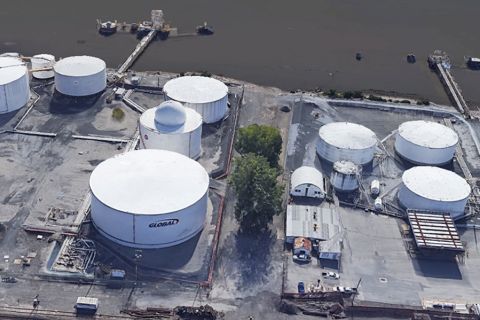
Learn more about Hart Energy Conferences
Get our latest conference schedules, updates and insights straight to your inbox.
The growth of U.S. crude oil exports has rightly garnered a lot of attention over the past few years as the country increases its share of the global market. However, OPEC will also retain its role as the marginal swing producer to 2040, according to a recent report from Wood Mackenzie.
The report, “Macro Oils Long-Term Outlook H1 2018,” says that while production out of the U.S. will be the key driver of global oil supply growth into the mid-2020s, OPEC will play an important role in the long-term balancing of the market.
Non-OPEC crude production has been very important to the global market since crude prices began to sharply decline in 2014, which resulted in upstream investment dropping by nearly 50%. Forecasts originally expected tighter supplies until 2020, but that has not been the case as production from non-OPEC countries has remained flat with improvements in efficiencies. It is also expected to remain flat until 2030 thanks to long decline rates.
This has led to some thinking that OPEC’s global influence is declining. But it’s important to note that it was OPEC and its partners that helped to rebalance the market over the past 18 months through a production restraint agreement.
U.S. crude production and exports will keep growing in the coming decades with much of this growth coming from the Permian Basin. Wood Mackenzie expects U.S. crude and condensate production to peak at 11.7 million barrels per day (bbl/d) in the early-2030s with Permian production accounting for approximately 6.3 million bbl/d in 2035.
It is expected that U.S. production will have a long plateau after this peak. However, global crude oil demand is expected to continue to grow, which will require an upswing in production from other producers to match this demand.
“As non-OPEC production growth slows and the importance of OPEC’s output increases from 2023, OPEC’s role in managing prices becomes more focused on ensuring upstream investment keeps up with replacing lost barrels from onstream declines, and the growth in oil demand over the next decade or so,” the report said.
Wood Mackenzie expects that new producers like Guyana, Uganda and Kenya will help make up for some production declines. The report said that these three nations will combine for about 700,000 bbl/d of crude being added to global output. However, mature producers such as China, Indonesia, Colombia and Mexico are expected to combine for about 2 million bbl/d of lost production in the 2030s.
Besides the U.S., Brazil and Canada are arguably the two most important non-OPEC producers, with both countries expected to see supply growth into the next decade. Crude production out of Russia and the North Sea is also forecasted to continue to grow over the next few years before beginning to decline in the 2020s.
It is possible that non-OPEC production gaps may not be as severe on a long-term basis as there has been an increase in new drilling projects moving ahead over the past few years. In 2017 there were 32 projects that secured financing to move forward and another 30 are expected to be announced by the end of 2018, according to Wood Mackenzie.
As producers improve their techniques, projected time frames for these projects to reach their peak production levels are much shorter than in the past. According to the report, before crude prices crashed projects would take an average of nine years to reach peak production. They are now averaging five years to reach peak production.
“This acts to lessen the post-2020 effects from the sharp downturn in new project sanctioning during 2015-2016. Although the projects are smaller, they will deliver a stronger production impact within a five-year timeframe,” the report said.
However, these projects are smaller than in the past and aren’t filling up the projected loss in reserves as average projected liquids reserves have fallen by more than half since crude prices crashed.
The biggest issue for non-OPEC producers, specifically the U.S., longer-term is a marked increase in production costs. According to Wood Mackenzie, about 6 million bbl/d of U.S. supply will have a breakeven price of $70/bbl by 2030. These volumes will consist of yet-to-be-found, contingent resources and fringe plays in the Lower 48 onshore. About 11 million bbl/d of U.S. volumes will have a breakeven price of more than $70/bbl by 2040.
These higher breakeven prices will make it harder to compete since they will require higher crude prices while OPEC is far less focused on breakeven prices as much as maintaining market share.
Recommended Reading
Mexico Pacific Appoints New CEO Bairstow
2024-04-15 - Sarah Bairstow joined Mexico Pacific Ltd. in 2019 and is assuming the CEO role following Ivan Van der Walt’s resignation.
Global Partners Declares Cash Distribution for Series B Preferred Units
2024-04-15 - Global Partners LP announced a quarterly cash dividend on its 9.5% fixed-rate Series B preferred units
W&T Offshore Adds John D. Buchanan to Board
2024-04-12 - W&T Offshore’s appointment of John D. Buchanan brings the number of company directors to six.
73-year Wildcatter Herbert Hunt, 95, Passes Away
2024-04-12 - Industry leader Herbert Hunt was instrumental in dual-lateral development, opening the North Sea to oil and gas development and discovering Libya’s Sarir Field.
Riley Permian Announces Quarterly Dividend
2024-04-11 - Riley Exploration Permian’s dividend is payable May 9 to stockholders of record by April 25.






